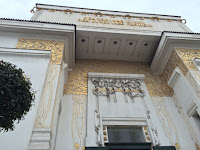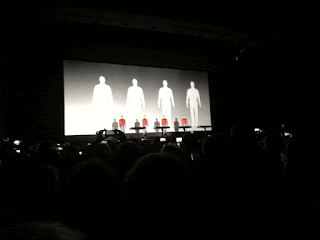
Whilst in Vienna, H and I of course paid our respects at what’s described as a temple to Art Nouveau (Jugendstil) design. The Secession Building is not a museum on the interior, as we discovered after being confronted with a gallery of quite nice but incongruous exhibition of grainy photographs of rippling water and stars—though I suppose appropriate for celebrating the centennial of
Einstein’s big and world-changing ideas, but rather as a hall for embracing the avant-garde as the founding artists had done.
The space was mostly empty and we had to wonder if this mop-head wasn’t in fact art or a decoy for one to make one’s own.
Descending to the basement, we discovered the Beethoven Frieze (
EN/
DE), created by
Gustav Klimt, which was really a transfixing sight to behold with all its receding references: an interpretation of the composer’s Ninth Symphony (also known as
Ode to Joy with lyrics by Friedrich Schiller), scored by Richard Wagner and performed by Max Klinger, in statuary-form.


The fresco itself also was executed only as a temporary decoration for a 1903 showing of contemporary artists, but was preserved by a collector with foresight and carefully prised off the wall upstairs before being installed in its permanent home. The Muse of Poetry looks like she’s consulting a tablet computer and does not want to be bothered (photography was not allowed and monitored, which made the experience all the more holy—down a rabbit hole of allegory) and stands in between an angelic choir and the monstrous giant Typhœus, the gorilla creature, attended by his Gorgon daughters—all elements in the struggle of the tone poem that became a national hymn.

The frieze ends with a knight in shining armour having doffed his protection and embracing his damsel in distress, illustrating the final stanza of “this kiss to the whole world,”
diesen Kuss der ganzen Welt. Outside we spied one of the ubiquitous pedestrian crossing signs that Vienna installed to celebrate its inclusive victory in the
Eurovision song contest—depicting the freedom to love whomever.
 True to their founding principles, the group, harking back to a formative time in 1970 in Düsseldorf when the genre of electronic was theirs to define, the ensemble gave a dazzling and unforgettable performance whose message is yet resonant throughout the decades—especially poignant considering how the whole audience, despite, in spite and rather because of their seniority were also viewing ad preserving the concert on their mobile devices. Their now signature use of the minimoog and the vocoder for synthesized voices on their 1975 album Autobahn cemented their international reputation and to English-speakers, the title song—progressing out of the experimental and desparaging label of “Krautrock,” fahren, fahren, fahren was a misunderstood lyric.
True to their founding principles, the group, harking back to a formative time in 1970 in Düsseldorf when the genre of electronic was theirs to define, the ensemble gave a dazzling and unforgettable performance whose message is yet resonant throughout the decades—especially poignant considering how the whole audience, despite, in spite and rather because of their seniority were also viewing ad preserving the concert on their mobile devices. Their now signature use of the minimoog and the vocoder for synthesized voices on their 1975 album Autobahn cemented their international reputation and to English-speakers, the title song—progressing out of the experimental and desparaging label of “Krautrock,” fahren, fahren, fahren was a misunderstood lyric. There was a significant pause while the stage-hands put out the iconic figures, during which I entertained for a moment the idea that the band might have invited the talented elementary school class in nearby Darmstadt that made their own version of Wir sind die Roboter to appear with them but I knew it was already well past their bedtimes.
There was a significant pause while the stage-hands put out the iconic figures, during which I entertained for a moment the idea that the band might have invited the talented elementary school class in nearby Darmstadt that made their own version of Wir sind die Roboter to appear with them but I knew it was already well past their bedtimes.





















